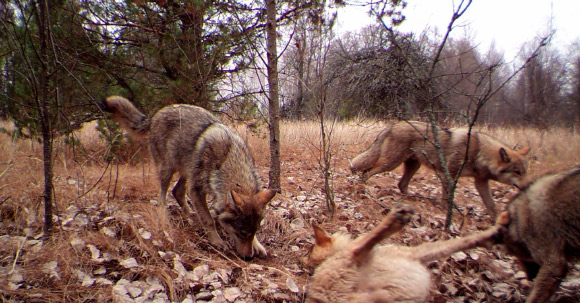New research published in the journal Frontiers in Ecology and the Environment documents animal species prevalent in the human-free Chernobyl Exclusion Zone — a 1,620-square-mile area of contamination around the Chernobyl nuclear plant — and supports the findings of a 2015 study that animal distribution is not influenced by radiation levels.

A pack of gray wolves visits a scent station in the Chernobyl Exclusion Zone. The photograph was taken by one of the remote camera stations and was triggered by the wolves’ movement. Image credit: Sarah Webster / Jim Beasley / National Geographic.
Following the 1986 Chernobyl accident in Ukraine, more than a hundred thousand people were permanently evacuated from the Chernobyl Exclusion Zone.
There is continuing scientific debate surrounding the fate of wildlife that remained in the abandoned area.
The previous study, published in October 2015, determined populations were thriving in the area by counting animal tracks.
Dr. James Beasley from the University of Georgia and his colleagues used a more contemporary research method — remote camera stations — to substantiate previous findings.
“The earlier study shed light on the status of wildlife populations in the Chernobyl Exclusion Zone, but we still needed to back that up,” Dr. Beasley said.
“For this study we deployed cameras in a systematic way across the entire Belarus section of the Chernobyl Exclusion Zone and captured photographic evidence because these are pictures that everyone can see.”
The study was conducted over a five-week period at 94 sites using 30 cameras. A remote camera was set up on a tree or tree-like structure for seven days at each location. Each station was equipped with a fatty acid scent to attract the animals.
“The team documented every species captured on the cameras and the frequency of their visits, specifically focusing on carnivores, because of their hierarchy on the food chain,” said study first author Sarah Webster, also from the University of Georgia.
The scientists observed individuals of 14 mammalian species in total.
The most frequently seen were the gray wolf (Canis lupus), raccoon dog (Nyctereutes procyonoides), Eurasian boar (Sus scrofa), and red fox (Vulpes vulpes).
All of these species were sighted at stations close to or within the most highly contaminated areas.
“We didn’t find any evidence to support the idea that populations are suppressed in highly contaminated areas,” Dr. Beasley said.
“What we did find was these animals were more likely to be found in areas of preferred habitat that have the things they need — food and water.”
“The study provides much needed verification, but further studies are needed to determine the density of wildlife and provide quantitative survival rates.”
_____
Sarah C. Webster et al. Where the wild things are: influence of radiation on the distribution of four mammalian species within the Chernobyl Exclusion Zone. Frontiers in Ecology and the Environment, published online April 18, 2016; doi: 10.1002/fee.1227







